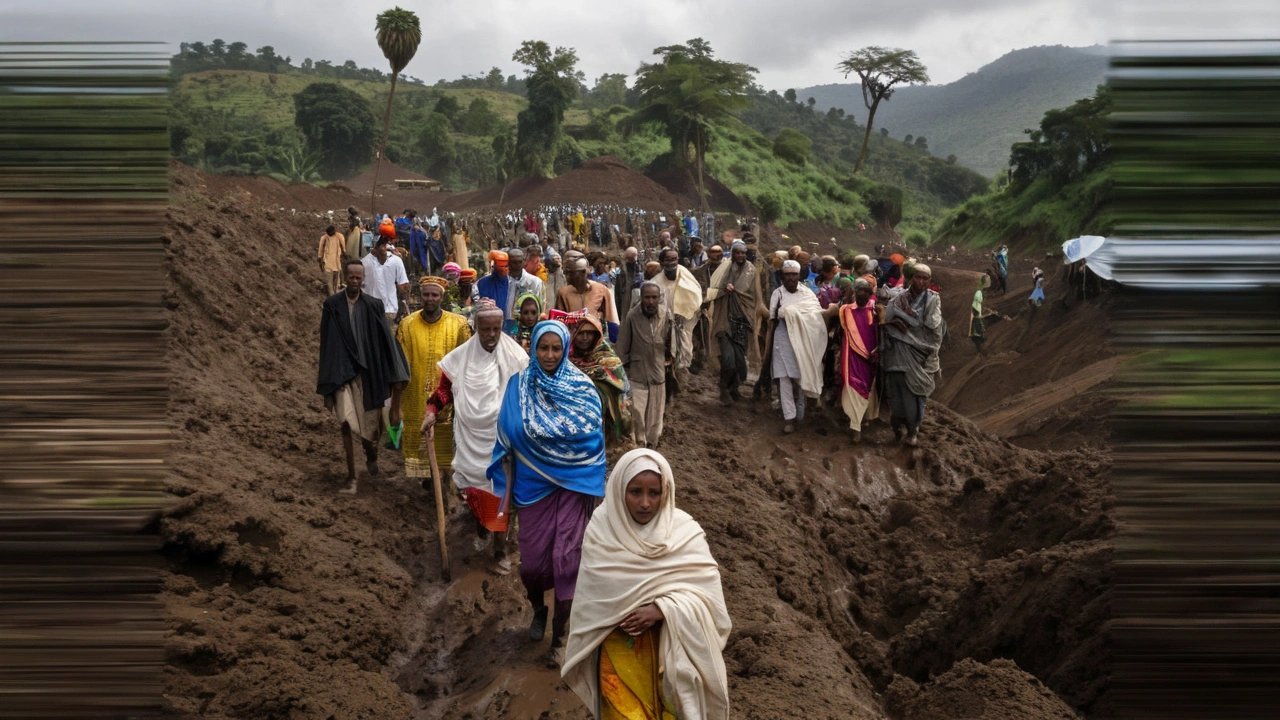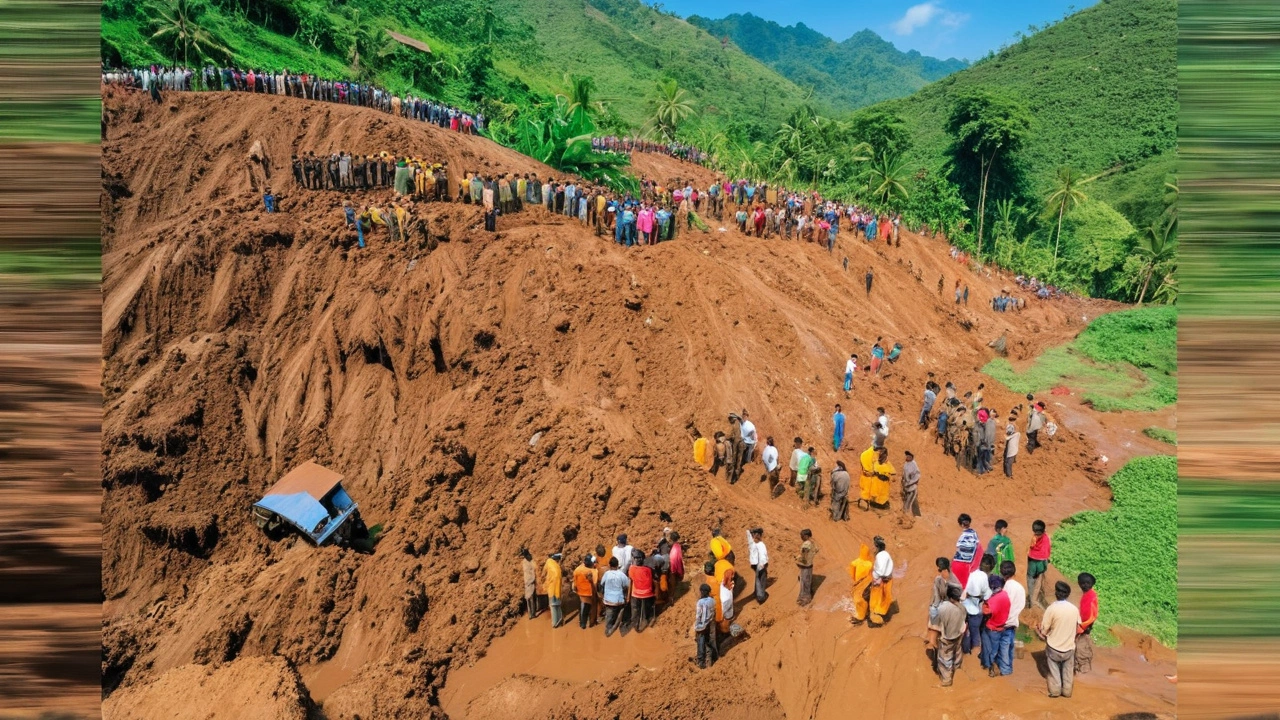Rescue Efforts Ongoing for Missing Individuals After Catastrophic Landslides in Ethiopia
 Jul, 26 2024
Jul, 26 2024
Desperate Rescue Missions in the Aftermath of Ethiopian Landslides
A series of devastating landslides has struck Ethiopia, particularly affecting the western Oromia region, where torrential rainfall has caused unimaginable destruction. These landslides, triggered by relentless rains, have led to the tragic loss of over 100 lives. As if this wasn’t heartbreaking enough, hundreds more individuals remain unaccounted for as rescue teams race against time to locate them.
The towns of Tiro and Gelana have been completely transformed by the landslides. Entire communities have been swept away, with homes, schools, and vital infrastructure buried under tons of rubble and mud. The local authorities, alongside national rescue units, face significant challenges in their search efforts. The rugged terrain coupled with the extensive destruction has rendered many areas inaccessible, hampering quick recovery missions.
Challenges Faced by Rescue Teams
Rescue teams are encountering numerous obstacles as they strive to navigate through the affected areas. The challenging landscape and treacherous conditions are not only slowing down the operations but also posing grave risks to the rescuers themselves. Moreover, the already disrupted communication networks due to the disaster have made coordination efforts exceedingly difficult.
Despite these hardships, the determination and resilience of the rescue teams shine through as they persist in their life-saving mission. Equipped with basic tools and often relying on their hands, these teams are working tirelessly, hoping against hope to find survivors amidst the debris. The stories of these brave men and women are a testament to the human spirit’s unwavering resolve in the face of adversity.
The Government and International Support
In response to this unprecedented crisis, the Ethiopian government has pledged substantial support to aid those affected. Measures have been put in place to provide immediate relief, which includes essential supplies such as food, water, and medical assistance. Simultaneously, efforts are being made to restore communication lines and rebuild the devastated infrastructure as swiftly as possible.
International organizations have not been left behind. Humanitarian aid groups and global relief agencies have rallied to provide much-needed support in the form of financial assistance, expert personnel, and emergency supplies. This confluence of local and international support is crucial in addressing both immediate needs and long-term recovery efforts for the affected communities.
Impact on Infrastructure and Economy
The long-term impact of these landslides on the region’s infrastructure and economy cannot be overstated. With roads, bridges, and other critical infrastructure either damaged or completely destroyed, the task of rebuilding will be a colossal undertaking. The economic cost is expected to be significant as commerce and trade in the region have come to a near standstill. This disaster threatens to plunge the area into further economic instability, exacerbating the hardship for the residents already grappling with the aftermath.
One of the immediate concerns is the potential for further landslides, particularly with the forecast of continued rainfall. Authorities have issued warnings and are on high alert, monitoring the situation to avert more tragic events. The precarious condition of the land in the aftermath means that even a relatively small amount of rain could trigger additional slides, posing an ongoing threat to already vulnerable communities.
Community Resilience and Future Precautions
Despite the overwhelming destruction, the spirit of the communities in Oromia remains unbroken. As rescue efforts continue, stories of resilience and solidarity are emerging. The residents are coming together, offering support to one another, and working collectively to cope with this disaster. Volunteers, non-governmental organizations, and community leaders are playing pivotal roles in mobilizing resources and providing comfort to those in need.
The Ethiopian government and international bodies are also looking to the future, focusing on implementing measures to mitigate the impact of such natural disasters. Plans are being discussed to improve early warning systems, reinforce infrastructure, and develop strategies that enhance community preparedness. The aim is to build a more robust framework that can withstand and respond to similar events better, minimizing loss of life and property.

Conclusion
The series of landslides in Ethiopia's Oromia region has led to an unprecedented crisis, with scores of lives lost and many more at risk. The efforts of rescue teams and the support from the government and international organizations have been commendable, but the road to recovery will be long and arduous. As the region grapples with the immediate aftermath and prepares for possible further dangers, the resilience of the communities and the continuous support from all quarters will be crucial in overcoming this catastrophe.

Michael Laffitte
July 26, 2024 AT 22:29My heart goes out to everyone in Oromia - the rescue crews are true heroes, and we’re all pulling for them from wherever we are.
sahil jain
July 27, 2024 AT 15:09Seeing how quickly the community and international teams have mobilized gives me hope that lives will be saved and families reunited soon.
Bruce Moncrieff
July 28, 2024 AT 10:36Honestly this disaster shows how fragile our world can be but also how resilient we are the teams are working around the clock digging through mud and rubble each breath they take feels like a prayer for those trapped deep inside the debris we must keep the momentum going and shout out support for every volunteer out there
Dee Boyd
July 29, 2024 AT 08:49It is an ethical imperative that governments allocate sufficient resources promptly; failure to do so not only jeopardizes rescue outcomes but also reflects systemic neglect of vulnerable populations.
Carol Wild
July 30, 2024 AT 09:49The sheer scale of the landslides in Oromia is not merely a natural tragedy but also a canvas upon which hidden agendas may be painted, for every major disaster creates opportunities for power structures to solidify their influence. One cannot ignore the pattern of delayed aid deliveries that have plagued previous crises, suggesting a possible bureaucratic inertia that borders on intentional obstruction. There are whispers among locals that certain road closure decisions were influenced by interests unrelated to safety, perhaps to reroute traffic away from lucrative mining sites. The international response, while generous on the surface, often comes bundled with conditionalities that benefit donor nations more than the affected communities. Furthermore, the media coverage tends to focus on the sensational aspects, leaving little room for discussions about long‑term environmental policies that might have prevented such catastrophic soil erosion. Satellite imagery reveals that deforestation rates had been climbing in the years preceding the landslides, a fact that authorities have been reluctant to acknowledge. The allocation of relief funds has historically shown a lack of transparency, raising legitimate concerns about misappropriation. In addition, the presence of foreign contractors in the reconstruction phase could be interpreted as a subtle form of economic colonization. The timing of the disaster, coinciding with upcoming elections, raises the unsettling possibility that political actors might exploit the tragedy to garner sympathy votes. Local NGOs report that community leaders are being pressured to align with certain political factions in exchange for assistance. Even the deployment of certain rescue equipment appears to favor suppliers tied to influential business conglomerates. The pattern of "quick fixes" without addressing root causes-such as inadequate land‑use planning-serves to perpetuate the cycle of vulnerability. Observations from independent geologists suggest that the region's geological instability was known, yet insufficient mitigation measures were implemented. One must also consider the role of climate change narratives being leveraged to secure additional funding that may never reach the ground level. Finally, the lack of a coordinated, community‑driven recovery plan points to an oversight that could be deeply rooted in a top‑down approach that marginalizes local voices. All these threads intertwine to form a complex tapestry that demands scrutiny beyond the immediate humanitarian outcry.
Rahul Sharma
July 30, 2024 AT 11:13From a geological perspective, the heavy precipitation saturated the lateritic soils, dramatically reducing shear strength, and the steep slopes in western Oromia provided just the right conditions for slope failure; additionally, the region’s deforestation has removed critical root reinforcement, further destabilizing the terrain, and the seismic micro‑tremors recorded prior to the slides suggest underlying tectonic stress that likely contributed to the magnitude of the landslides, so the combination of hydrological loading, anthropogenic land‑use changes, and inherent geological weaknesses created a perfect storm for the disaster we are witnessing today.
Emily Kadanec
July 31, 2024 AT 03:53Actually the UN already sent a logistics hub to the area, not just “aid” but a full blown operation.
william wijaya
July 31, 2024 AT 14:59It’s heartbreaking to picture those rescuers pulling themselves through waist‑deep mud, their helmets slick with grime, yet their determination shines brighter than any flashlight they carry, and every life they bring to the surface is a testament to human compassion in the worst of conditions.
Lemuel Belleza
August 1, 2024 AT 04:53These reports feel like recycled boilerplate, nothing new.
faye ambit
August 1, 2024 AT 13:13When we contemplate the fragility of life amid such overwhelming force, we are reminded that solidarity is not just a moral choice but a shared acknowledgement of our interdependence, and nurturing that connection can become the quiet strength that sustains communities through the darkest hours.
Subhash Choudhary
August 2, 2024 AT 00:19All in all, let’s keep the conversation focused on practical ways to support those on the ground and ensure the relief effort stays transparent and effective.